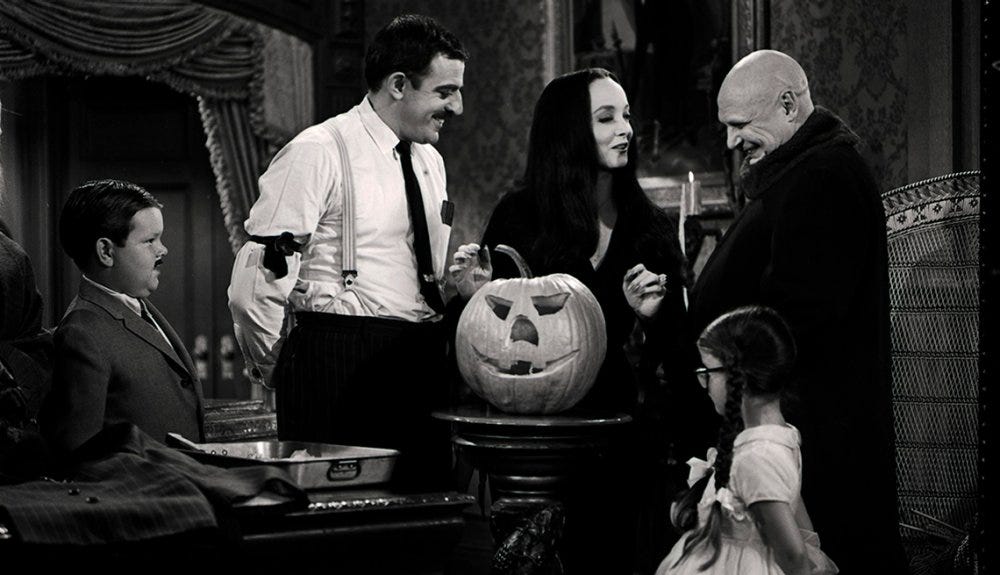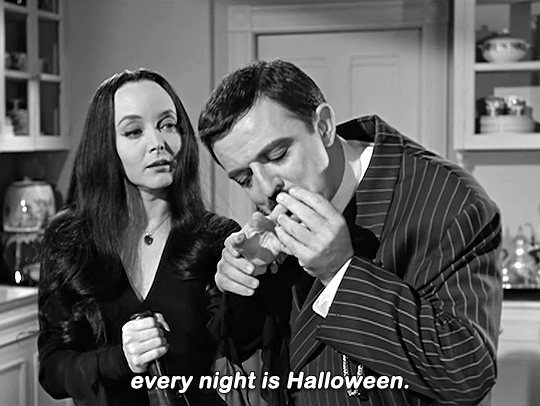The Addams Family's "Halloween Poem" Anticipates a Tim Burton Masterpiece
Not a creature was stirring... not even a toad.
Want to stay up to date with all things PopPoetry? Follow the new dedicated account @pop__poetry for news and extras!
Happy Halloween! Been enjoying these themed posts from PopPoetry? Next week’s subscriber-only post will focus on a staple of Halloween and winter holiday viewing: Tim Burton’s The Nightmare Before Christmas. We’ve got a delightful creepy appetizer on offer today, but if you’d like to read next week’s post on the animated holiday classic and the poem it was inspired by, upgrade your subscription today!
My goal is to serve as a resource for those interested in the poetry they see and hear on film, in music, on TV, in video games, and elsewhere in the pop culture ether. Poetry has the connotation of existing only for certain kinds of readers, and my mission is to topple that old-fashioned idea for readers both young and old. I also offer writing exercises and meditations on creativity for makers of all stripes.
Your support means everything to me: PopPoetry is a labor of love, and paying for a subscription will help me pay honorariums to guest writers, offer new features, and continue writing weekly.
Thanks for reading and supporting PopPoetry!
Today, we’ll look at an interesting precursor to Tim Burton’s masterpiece in advance of next week’s post: the 1964 Addams Family Halloween Special.
Like The Nightmare Before Christmas, The Addams Family’s “Halloween poem” was inspired by Clement C. Moore’s “A Visit from St. Nicholas,” the most famous poem ever written about that other holiday (which we do not speak of at this time of the year… at least not in my house).
In this episode, the Addams’ annual Halloween festivities are interrupted by a pair of would-be robbers that the family mistakes for party guests. During their farcical visit, Gomez recites the following poem from a deliciously ancient-looking scroll of parchment as the family and “guests” are gathered around. But just before that can happen, one of the would-be robbers delivers one of the most delightful poetry insults ever:
A poem?? We’d be better off in jail!
Uncle Fester dims the lights and then becomes a light, complete with a lightbulb in his mouth. Lurch accompanies on harpsichord. Gomez begins, and other family members chime in to assist:
GOMEZ: It was Halloween evening, and through the abode Not a creature was stirring, not even a toad. Jack o' Lanterns are hung on the gallows with care... MORTICIA: ...to guide sister Witch as she flies through the air. GOMEZ (aside): Drawn by eight beautiful bats... And she calls out to them: MORTICIA: "Come Flitter, come Flutter, come Flapper and Flier... FESTER: ...come Chitter, come Chatter, come Vicious Vampire!"
The reading is interrupted at this point by the fleeing robbers, who are freaked out by Fester looming over them, removing the lightbulb in his mouth long enough to shout some of the names of the bats. When Morticia wonders why their “guests” are leaving, Gomez delivers another great punchline:
It’s obvious… they just don’t like poetry!
The shortening of the poem is comedically excellent but a huge bummer for poetry fans. Halloween needs its own canonical poem, and though it would be better to have an original work not based on a winter holiday poem (no, I will not say it… get your candy canes away from me until Black Friday OR ELSE), this would have been a worthy entry in the genre if it were complete.
Because of the interruption, we only get the names of seven of the bats: flitter, flutter, flapper, flier, chitter, chatter, and vicious vampire. First, Vicious Vampire has the most badass name of all the bats listed. But what do you think the unnamed eighth bat would have been called?
These are the questions. Do I need a hobby? Right, right… this is my hobby. Moving on!
The Addams Halloween Poem retains a great deal of Moore’s structure, right down to the anapestic tetrameter. That’s four stressed syllables per line, each line being primarily made up of anapests (the stress pattern of the word “overcome,” for example—da da DUM). The poem also serves the same cultural purpose as poetry has done for eons: to be read aloud for pleasure and connection. It’s wonderful to see different family members chiming in to read some of their favorite parts, too. This is the best-case scenario for poetry in that it becomes a ritual or tradition that is shared and enjoyed.
From its structure to its usage, the poem is a lovely homage to Moore that also anticipates Tim Burton’s 1993 The Nightmare Before Christmas, which also blends elements of Moore’s poem to tell a new and different story about Halloween but retains some of the spirit and techniques of the original.
You can watch the whole episode here (the Halloween poem scene begins around the 14:34 mark):
Next week we’ll dig into the poetic origins of The Nightmare Before Christmas and investigate the extent to which Clement C. Moore’s original poem contains some hidden horrors of its own… spooky.
Subscribe below so you won’t miss it!
Related
How Wednesday Addams Got Her Name
Who’s your Wednesday Addams? If you’re a Baby Boomer, it’s probably the late Lisa Loring of The Addams Family, a TV show that aired on ABC for two memorable seasons in the mid-1960s and sparked a slew of reinterpretations. For a Millennial like me, it’s unequivocally Christina Ricci, whose early…







